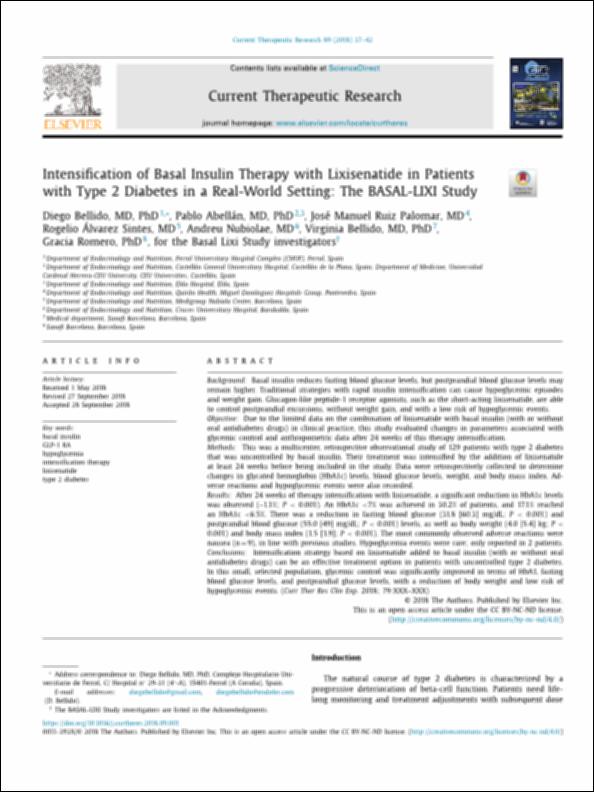Please use this identifier to cite or link to this item:
http://hdl.handle.net/10637/10521Intensification of basal insulin therapy with Lixisenatide in patients with Type 2 Diabetes in a real-world setting : the BASAL-LIXI study
| Title: | Intensification of basal insulin therapy with Lixisenatide in patients with Type 2 Diabetes in a real-world setting : the BASAL-LIXI study |
| Authors : | Bellido, Diego Abellán Galiana, Pablo Ruiz Palomar, José Manuel Álvarez Sintes, Rogelio Nubiolae, Andreu Bellido, Virginia Romero, Gracia |
| Keywords: | Diabetes - Farmacoterapia.; Insulin - Therapeutic use - Testing.; Hypoglycemia - Chemotherapy.; Diabetes - Chemotherapy.; Diabetes - Treatment.; Hipoglucemia - Farmacoterapia.; Lixisenatida.; Lixisenatide.; Diabetes - Tratamiento.; Hipoglucemia - Tratamiento.; Insulina - Uso terapéutico - Ensayos clínicos.; Hypoglycemia - Treatment. |
| Publisher: | Elsevier |
| Citation: | Bellido, D., Abellán, P., Ruiz Palomar, JM., Álvarez Sintes, R., Nubiolae, A., Bellido, V. et al. (2018). Intensification of basal insulin therapy with Lixisenatide in patients with Type 2 Diabetes in a real-world setting : the BASAL-LIXI study. Current Therapeutic Research, vol. 89), pp. 37-42. DOI: https://doi.org/10.1016/j.curtheres.2018.09.001 |
| Abstract: | Background: Basal insulin reduces fasting blood glucose levels, but postprandial blood glucose levels may remain higher. Traditional strategies with rapid insulin intensification can cause hypoglycemic episodes and weight gain. Glucagon-like peptide-1 receptor agonists, such as the short-acting lixisenatide, are able to control postprandial excursions, without weight gain, and with a low risk of hypoglycemic events. Objective: Due to the limited data on the combination of lixisenatide with basal insulin (with or without oral antidiabetes drugs) in clinical practice, this study evaluated changes in parameters associated with glycemic control and anthropometric data after 24 weeks of this therapy intensification. Methods: This was a multicenter, retrospective observational study of 129 patients with type 2 diabetes that was uncontrolled by basal insulin. Their treatment was intensified by the addition of lixisenatide at least 24 weeks before being included in the study. Data were retrospectively collected to determine changes in glycated hemoglobin (HbA1c) levels, blood glucose levels, weight, and body mass index. Ad- verse reactions and hypoglycemic events were also recorded. Results: After 24 weeks of therapy intensification with lixisenatide, a significant reduction in HbA1c levels was observed (–1.1%; P < 0.001). An HbA1c < 7% was achieved in 30.2% of patients, and 17.1% reached an HbA1c < 6.5%. There was a reduction in fasting blood glucose (31.8 [60.3] mg/dL; P < 0.001) and postprandial blood glucose (55.0 [49] mg/dL; P < 0.001) levels, as well as body weight (4.0 [5.4] kg; P < 0.001) and body mass index (1.5 [1.9]; P < 0.001). The most commonly observed adverse reactions were nausea (n = 9), in line with previous studies. Hypoglycemia events were rare; only reported in 2 patients. Conclusions: Intensification strategy based on lixisenatide added to basal insulin (with or without oral antidiabetes drugs) can be an effective treatment option in patients with uncontrolled type 2 diabetes. In this small, selected population, glycemic control was significantly improved in terms of HbA1, fasting blood glucose levels, and postprandial glucose levels, with a reduction of body weight and low risk of hypoglycemic events. |
| Description: | Este artículo se encuentra disponible en la siguiente URL: https://www.sciencedirect.com/science/article/pii/S0011393X18300298 |
| URI: | http://hdl.handle.net/10637/10521 |
| Rights : | http://creativecommons.org/licenses/by-nc-nd/4.0/deed.es |
| ISSN: | 0011-393X. 1879-0313 (Electrónico). |
| Issue Date: | 1-Jul-2018 |
| Center : | Universidad Cardenal Herrera-CEU |
| Appears in Collections: | Dpto. Medicina y Cirugía |
Items in DSpace are protected by copyright, with all rights reserved, unless otherwise indicated.


